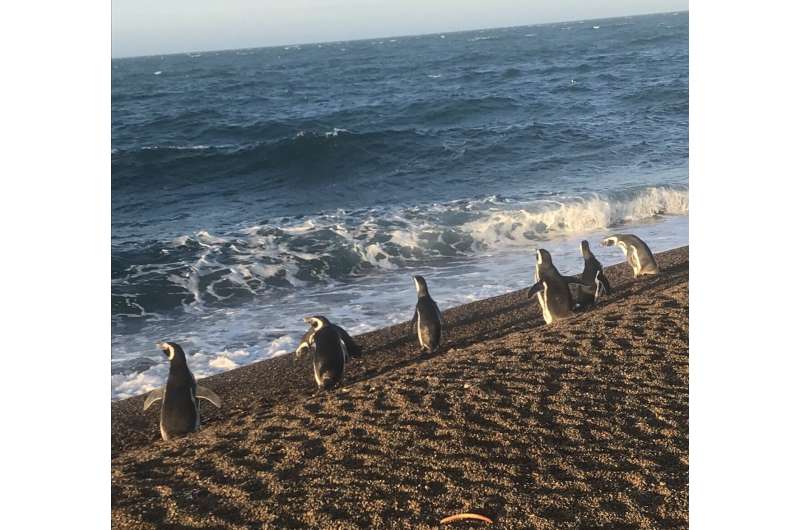Science
Magellanic Penguins Navigate Using Ocean Currents for Energy Efficiency

A recent study has revealed that Magellanic penguins may use ocean currents to optimize their energy expenditure during long foraging trips. Conducted by Richard Michael Gunner and his team at the Max-Planck-Institut für Verhaltensbiologie in Germany, the research was published in PLOS Biology on July 17, 2025. The findings suggest that these penguins can sense current drift and adjust their navigation strategies accordingly.
The study focused on understanding how Magellanic penguins navigate over vast distances without the aid of visible landmarks. The researchers fitted 27 adult penguins from the San Lorenzo Magellanic penguin colony in Peninsula Valdés, Argentina, with GPS and IMU loggers. Each penguin’s foraging trip was recorded before the devices were removed, allowing for an analysis of various movement parameters such as dive profiles, compass headings, speeds, and durations.
Findings indicate that during periods of calm currents, penguins maintained a direct route towards their colony. In contrast, when confronted with stronger currents, they adapted their swimming patterns to flow with the current. This strategy increased their travel distance but conserved energy, demonstrating an awareness of the current drift relative to their out-of-sight destination.
The researchers noted that while navigating under strong currents, the penguins displayed a more dispersed heading distribution. This behavior suggests that they engage in repeated adjustments to compensate for drift while still aiming toward their intended location. According to the authors, “Our results indicate that penguins notice discrepancies between their intended path and actual displacement over ground, then adjust accordingly.”
While these findings are significant, the researchers acknowledged that the study’s scope was limited to a single foraging trip for each of the 27 penguins. They emphasize the need for further investigations to replicate the results across different penguin populations and other marine species. Future studies may also explore the mechanisms by which penguins detect and adapt to varying ocean currents.
The authors highlight the intricate navigation abilities of Magellanic penguins, stating, “Magellanic penguins finding their way back to their nests from the open ocean subtly adjust their headings to exploit tidal currents, following paths that reduce energy costs while maintaining remarkable accuracy.” Rather than swimming directly home, these penguins drift laterally with the tides, balancing travel efficiency with opportunistic foraging along the way.
This research contributes valuable insights into the navigation strategies of marine animals, enhancing our understanding of how they interact with their environment to optimize energy use during long-distance travel. The study serves as a reminder of the complexity of animal behavior and the adaptability of species like the Magellanic penguin in the face of challenging conditions.
-

 Health3 months ago
Health3 months agoNeurologist Warns Excessive Use of Supplements Can Harm Brain
-

 Health3 months ago
Health3 months agoFiona Phillips’ Husband Shares Heartfelt Update on Her Alzheimer’s Journey
-

 Science2 months ago
Science2 months agoBrian Cox Addresses Claims of Alien Probe in 3I/ATLAS Discovery
-

 Science2 months ago
Science2 months agoNASA Investigates Unusual Comet 3I/ATLAS; New Findings Emerge
-

 Science1 month ago
Science1 month agoScientists Examine 3I/ATLAS: Alien Artifact or Cosmic Oddity?
-

 Entertainment5 months ago
Entertainment5 months agoKerry Katona Discusses Future Baby Plans and Brian McFadden’s Wedding
-

 Science1 month ago
Science1 month agoNASA Investigates Speedy Object 3I/ATLAS, Sparking Speculation
-

 Entertainment4 months ago
Entertainment4 months agoEmmerdale Faces Tension as Dylan and April’s Lives Hang in the Balance
-

 World3 months ago
World3 months agoCole Palmer’s Cryptic Message to Kobbie Mainoo Following Loan Talks
-

 Science1 month ago
Science1 month agoNASA Scientists Explore Origins of 3I/ATLAS, a Fast-Moving Visitor
-

 Entertainment2 months ago
Entertainment2 months agoLewis Cope Addresses Accusations of Dance Training Advantage
-

 Entertainment3 months ago
Entertainment3 months agoMajor Cast Changes at Coronation Street: Exits and Returns in 2025









